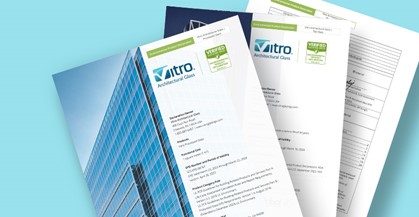Vitro Architectural Glass Lowers Embodied Carbon Further, Releases NEW Environmental Product Declarations
PITTSBURGH, PA June 15, 2023 — Vitro Architectural Glass (formerly PPG Glass) has published updated versions of its Environmental Product Declarations (EPDs) for both flat and processed glass. These updates reaffirm that Vitro’s glass products contain less embodied carbon than the industry standard for architectural glass products and indicate a lower embodied carbon value than previously reported in 2017 editions of these EPDs.

Vitro Architectural Glass publishes updated editions of its EPDs for 2023
EPDs offer detailed data about the embodied carbon values and life-cycle impact on the environment of a wide range of architectural building products, including information about the extraction, transportation and processing of related raw materials, and can be used as credentialing documentation for sustainability certifications such as the U.S. Green Building Council’s Leadership in Energy and Environmental Design (LEED ®) Certification.
As a standard measure of embodied carbon, EPDs calculate a value of global warming potential (GWP) that is expressed as kilograms of CO2 equivalent.
In 2017, Vitro became the first North American manufacturer to publish third-party verified EPDs for its flat glass and processed glass products.
In 2019, the National Glass Association (NGA) published an architectural glass EPD that evaluated the embodied carbon of clear, low-iron and tinted flat glass produced by four member companies of the NGA’s Forming Committee, including Vitro. Its findings suggested an industry average GWP of 1430 for comparable products.
Vitro’s 2023 EPDs indicate that its products contain just 1350 kilograms of CO2 equivalent, which is 6% lower than the NGA’s industry standard figure and an improvement on figures reported in 2017.
Vitro’s lower GWP was driven by several key steps taken by Vitro’s production teams to lower embodied carbon generated during glass production. These include more efficient use of batch material, implementing furnace efficiency and design improvements, installing energy-efficient lighting and regulating equipment and driving supplier improvements. A highlight of these efforts is Vitro’s pioneering use of oxy-fuel technology at three plant locations in the U.S., which can reduce energy consumption in glass melting furnaces by as much as 20% and cut greenhouse gas emissions in half.
These enhancements create opportunities to reduce embodied carbon in architectural glass production, which is otherwise challenging to accomplish because flat glass manufacturing itself makes up more than 75% of the GWP of double-pane insulating glass units (IGUs). Other processes such as heat treatment, the application of low-e coatings or even the assembly of the IGU itself contribute significantly less to GWP of glass.
“EPDs have become extremely valuable as green building certifications and sustainable design have become more mainstream and architects demand greater transparency in their product selections,” said Mike Hammond, manager, technical support, Vitro Architectural Glass. “We’re pleased to be able to offer EPDs for our glass products that attest to Vitro’s lower embodied carbon values, especially with this latest update.”
More significant than the lower GWP value is the improved data that was used to determine the GWP value. Vitro’s 2023 EPDs were produced using the NGA’s updated 2020 Product Category Rules (PCR), which provide more precise data for a more confident calculation of embodied carbon. Additionally, Vitro submitted 24 months of production data from its plants for its 2023 EPDs compared to 12 months of data in 2017. These methodological improvements ensure the improved results are sound.
The product-specific flat glass EPD is valid for annealed and untreated glass products manufactured by Vitro in the United States. The product-specific processed glass EPD is valid for Vitro products that undergo secondary treatment, such as the addition of low-emissivity (low-e) coatings, heat-strengthening or fabrication into multi-pane IGUs.
Both EPDs are certified by ASTM International as conforming to the requirements of ISO 14025. Life cycle assessments (LCAs) for flat glass and processed glass products were performed according to ISO 14040, ISO 14044 and ISO 21930 following the PCRs for each product type.
To learn more about Vitro and its commitment to sustainability transparency, please visit www.vitroglazings.com or call 1-855-VTRO-GLS (887-6457).
About Vitro Architectural Glass
Vitro Architectural Glass, part of Vitro, S.A.B. de C.V. (BMV: VITROA), is the largest glass producer in the Western Hemisphere, manufacturing a range of industry-leading, energy-efficient, high-performance products such as Solarban®, Sungate® and Starphire Ultra-Clear® glasses. Committed to continually raising the industry standard for sustainability, Vitro was the first U.S. glass manufacturer to have its entire collection of architectural glass products earn Cradle to Cradle Certified® status and the first North American manufacturer to publish third-party verified Environmental Product Declarations (EPDs) for flat glass and processed glass products. Additionally, all Vitro architectural glass products meet the Top 20% Low Embodied Carbon (LEC) material category based on standards set by the Inflation Reduction Act of 2022 and the U.S. General Services Administration (GSA). Vitro operates seven glass production facilities across North America, four residential glass fabrication plants in Canada and one of the world’s largest glass research and development facilities in Pittsburgh, Pennsylvania. For more information, please visit VitroGlazings.com.

Media Contact:
Robert J. Struble
Vitro Architectural Glass
412-820-8138
rstruble@vitro.com
www.vitroglazings.com
